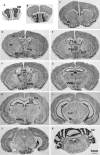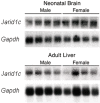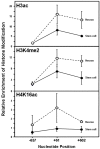Sex-specific expression of the X-linked histone demethylase gene Jarid1c in brain
- PMID: 18596936
- PMCID: PMC2438472
- DOI: 10.1371/journal.pone.0002553
Sex-specific expression of the X-linked histone demethylase gene Jarid1c in brain
Abstract
Jarid1c, an X-linked gene coding for a histone demethylase, plays an important role in brain development and function. Notably, JARID1C mutations cause mental retardation and increased aggression in humans. These phenotypes are consistent with the expression patterns we have identified in mouse brain where Jarid1c mRNA was detected in hippocampus, hypothalamus, and cerebellum. Jarid1c expression and associated active histone marks at its 5'end are high in P19 neurons, indicating that JARID1C demethylase plays an important role in differentiated neuronal cells. We found that XX mice expressed Jarid1c more highly than XY mice, independent of their gonadal types (testes versus ovaries). This increased expression in XX mice is consistent with Jarid1c escape from X inactivation and is not compensated by expression from the Y-linked paralogue Jarid1d, which is expressed at a very low level compared to the X paralogue in P19 cells. Our observations suggest that sex-specific expression of Jarid1c may contribute to sex differences in brain function.
Conflict of interest statement
Figures




References
-
- Tzschach A, Lenzner S, Moser B, Reinhardt R, Chelly J, et al. Novel JARID1C/SMCX mutations in patients with X-linked mental retardation. Hum Mutat. 2006;27:389. - PubMed
-
- Iwase S, Lan F, Bayliss P, de la Torre-Ubieta L, Huarte M, Qi HH, Whetstine JR, Bonni A, Roberts TM, Shi Y. The X-Linked Mental Retardation Gene SMCX/JARID1C Defines a Family of Histone H3 Lysine 4 Demethylases. Cell. 2007;128:1077–1088. - PubMed
-
- Christensen J, Agger K, Cloos PA, Pasini D, Rose S, Sennels L, Rappsilber J, Hansen KH, Salcini AE, Helin K. RBP2 belongs to a family of demethylases, specific for tri-and dimethylated lysine 4 on histone 3. Cell. 2007;128:1063–76. - PubMed
-
- Lee N, Zhang J, Klose RJ, Erdjument-Bromage H, Tempst P, Jones RS, Zhang Y. The trithorax-group protein Lid is a histone H3 trimethyl-Lys4 demethylase. Nat Struct Mol Biol. 2007;14:341–3. - PubMed
Publication types
MeSH terms
Substances
Grants and funding
LinkOut - more resources
Full Text Sources

